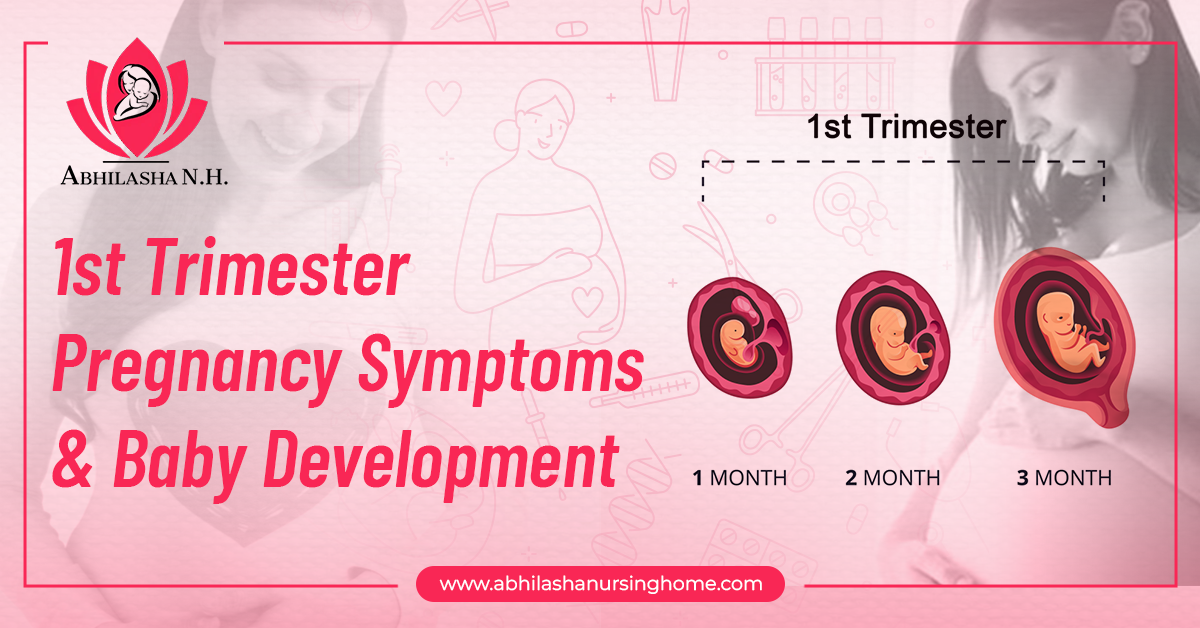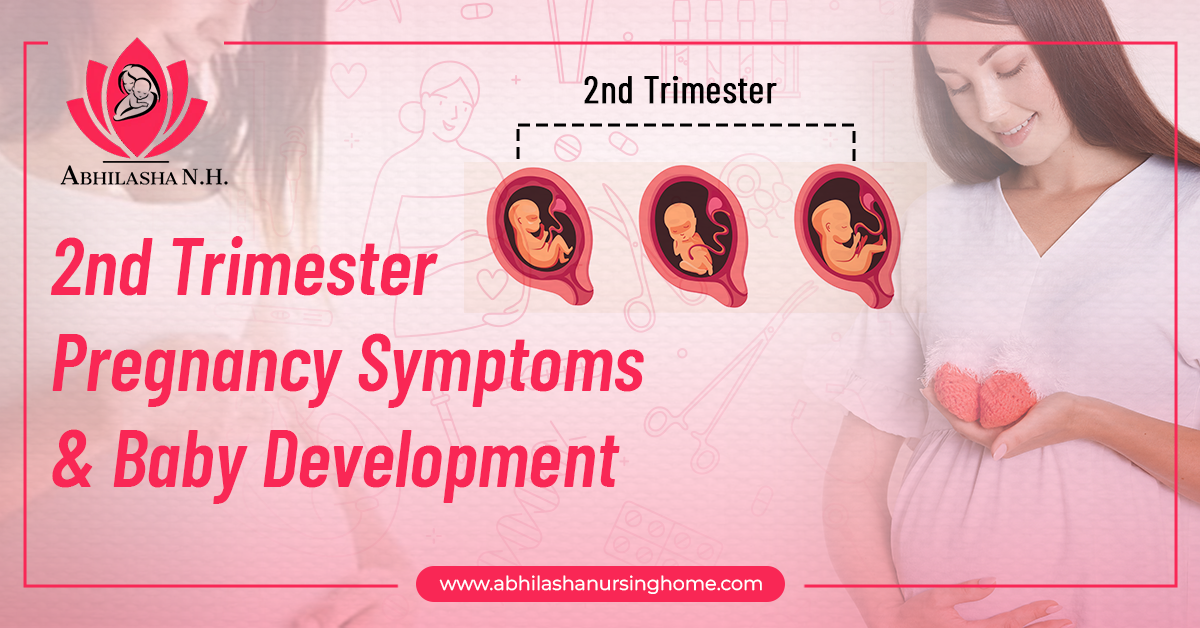Fetal Development stages of Pregnancy: Guide from Conception to Birth Explained by Our senior Dr. Abhilasha Prakash (Obstetrician-gynecologist) MBBS, DGO, MS, expert in GYNAE, OBS and Infertility with 32+ Years of experience.
Pregnancy is a remarkable journey filled with continuous growth and transformation. Understanding how a baby develops each week helps expectant parents prepare for the exciting changes ahead. Here is the guide for an insightful look into each stage of pregnancy, highlighting crucial milestones and what to expect during each trimester.
Within a day (24 Hours) after fertilization, the single egg that will eventually grow into your baby begins to divide rapidly, multiplying into numerous cells. As the pregnancy progresses, by the ninth week, this developing cluster of cells transitions from an embryo into what is officially known as a fetus. A full-term pregnancy typically lasts around 40 weeks, which are systematically divided into three distinct stages called trimesters, each marking crucial phases of growth and development.
Understand Three Stages of Fetal Development
According to Dr. Abhilasha Prakash, fetal development is a complex journey that begins before pregnancy is even detected and continues until birth. This process unfolds in three stages: germinal, embryonic, and fetal. While these terms are not commonly used in everyday conversations, understanding them can provide valuable insights into a baby’s growth.
1. Germinal Stage (Weeks 1-2)
This is the earliest stage, beginning at fertilization when the sperm and egg unite to form a zygote. The zygote undergoes rapid cell division and travels through the fallopian tube to the uterus. By the end of the second week, it implants itself into the uterine lining, officially marking the start of pregnancy.
2. Embryonic Stage (Weeks 3-8)
During this phase, the embryo begins developing major organs and body structures, such as the heart, brain, spinal cord, and limbs. The placenta also forms, providing nutrients and oxygen. This is a critical stage, as the foundation for the baby’s entire body is being built.
3. Fetal Stage (Weeks 9-Birth)
At this point, the embryo is now called a fetus. The focus shifts from organ formation to growth and development. The baby’s features become more defined, movements increase, and vital functions like breathing and swallowing begin. By the third trimester, the fetus gains weight rapidly in preparation for birth.
Each stage is essential in ensuring a healthy pregnancy and a fully developed baby.
Stages of Pregnancy: 1st, 2nd, and 3rd Trimester Pregnancy
A full-term pregnancy lasts about 40 weeks or 280 days. Some pregnancies may extend to 42 weeks, while others may conclude earlier due to medical considerations.
During pregnancy, the fetus goes through many changes as it grows and develops. A full pregnancy is divided into three trimesters, each lasting about three months.
Pregnancy Doctor usually track pregnancy by weeks rather than months. For example, if you are three months pregnant, that means you are around 12 weeks along.
Throughout each trimester, both you and your baby will experience noticeable changes. The baby’s body develops in stages, while you may feel different symptoms as your pregnancy progresses.
First Trimester (Week 1 to 12) Pregnancy Symptoms & Guide

The first trimester is the earliest stage of pregnancy, covering the first 12 weeks. This is a crucial period where the baby’s basic structures begin to form, and your body undergoes significant changes.
Baby’s Development:
- The fertilized egg implants in the uterus and starts growing.
- The heart, brain, spinal cord, and major organs begin forming.
- By the end of this trimester, the baby has tiny fingers, toes, and facial features.
- The baby is now called a fetus and is about the size of a plum.
Changes in the Mother’s Body:
- Hormonal changes may cause morning sickness, fatigue, and mood swings.
- Breasts may feel tender and start preparing for milk production.
- Some women experience food cravings or aversions.
- A small baby bump may start to appear by the end of this stage.
Since the first trimester is when the baby’s organs are developing, it’s a sensitive time. Eating healthy, avoiding harmful substances, and regular prenatal checkups to ensure healthy pregnancy.
Week 1 to Week 12 Pregnancy Symptoms, Guide & Tips:
Second Trimester (Weeks 13-28) Pregnancy Symptoms & Guide

The second trimester is often considered the “honeymoon phase” of pregnancy, as many of the early symptoms like morning sickness and fatigue begin to subside. This is a time of significant growth and development for both you and your baby. It is also the period when you’ll likely start feeling the baby’s movements and noticing more physical changes.
Baby’s Development:
- Rapid Growth: During the second trimester, your baby will experience rapid growth. By the end of this period, your baby may weigh between 1-2 pounds and be about 10-14 inches long.
- Development of Features: The baby’s facial features become more distinct, and they may begin to grow hair on their head and eyebrows. Tiny fingernails and toenails also begin to form.
- Movement and Kicks: Around week 16 to 20, many mothers begin feeling the baby move. These movements are often referred to as “quickening,” and they become more noticeable as the baby grows stronger.
- Organ and System Development: Major organs such as the heart, kidneys, and liver continue to mature. The baby’s digestive and circulatory systems are developing, and by the end of the second trimester, the baby’s lungs are practicing breathing movements, though they aren’t yet capable of functioning outside the womb.
- Sexual Development: If you choose to find out, the baby’s sex is clearly identifiable via ultrasound by this time, as the external genitalia have formed.
- Hearing and Vision: The baby’s sense of hearing begins to develop, and they may start responding to sounds. Their eyes, though still closed, are becoming more sensitive to light.
Changes in the Mother’s Body:
- Reduced Morning Sickness: For many women, the nausea and vomiting of the first trimester start to diminish, leading to a renewed sense of energy.
- Increasing Belly Size: The uterus grows significantly during this trimester, and you may begin to show a more pronounced baby bump. Your waistline will become less defined, and your belly will start to expand outward.
- Skin Changes: As your body adjusts to the hormonal changes, you might notice changes in your skin, such as the “pregnancy glow” or the appearance of dark lines on your belly (linea nigra). Some women also develop stretch marks as the skin stretches to accommodate the growing baby.
- Breast Changes: Your breasts may continue to grow and feel more tender. The areolas may darken, and veins may become more visible due to increased blood flow.
- Increased Appetite: With the reduction in nausea, many women experience an increase in appetite and begin to eat more as the baby requires more nutrients.
- Increased Energy: The fatigue from the first trimester starts to wear off, and you may feel more energetic and able to resume normal activities.
- Pregnancy Glow: The hormonal changes often result in smoother, healthier-looking skin and shinier hair, earning this period its reputation for a “pregnancy glow.”
- Leg Cramps and Back Pain: As your body continues to adapt to pregnancy, you may experience some leg cramps and lower back pain due to the weight of the growing baby and hormonal changes that affect your joints.
2nd Trimester Week by Week Guide to stages of Pregnancy:
| 13 Weeks Pregnant | 14 Weeks Pregnant | 15 Weeks Pregnant |
| 16 Weeks Pregnant | 17 Weeks Pregnant | 18 Weeks Pregnant |
| 19 Weeks Pregnant | 20 Weeks Pregnant | 21 Weeks Pregnant |
| 22 Weeks Pregnant | 23 Weeks Pregnant | 24 Weeks Pregnant |
| 25 Weeks Pregnant | 26 Weeks Pregnant | 27 Weeks Pregnant |
| 28 Weeks Pregnant | – | – |
Preparation for the Third Trimester:
As you approach the end of the second trimester, your doctor will begin monitoring your baby’s growth and well-being more closely. Regular prenatal visits will include checking the baby’s heartbeat, measuring your belly’s size, and possibly doing an ultrasound to check on the baby’s development. You may also be screened for gestational diabetes around week 24-28.
In this trimester, it’s essential to continue practicing healthy habits such as eating a balanced diet, staying active with safe exercises, and attending prenatal checkups to prepare your body for a smooth and healthy delivery.
Third (3rd) Trimester Pregnancy Symptoms (Weeks 29 to 40)

The third trimester marks the final stretch of pregnancy, and it’s a time of rapid growth and development for your baby, along with significant changes in your body as it prepares for labor and delivery. This stage typically begins at week 29 and continues until you give birth, which can be anywhere from 37 to 42 weeks. It’s an exciting yet challenging period as you approach the birth of your baby.
Baby’s Development:
- Size and Growth: The baby’s size increases dramatically during the third trimester. By the end of this stage, the baby typically weighs around 6-9 pounds and measures 18-22 inches long.
- Brain Development: Your baby’s brain undergoes rapid development, especially in the last few weeks. Neural connections are forming rapidly, and your baby is learning how to regulate their body temperature and respond to stimuli like sounds, light, and touch.
- Lung Development: The lungs continue to mature, and by the end of this trimester, your baby will be capable of breathing air. However, they may still require medical assistance if born prematurely.
- Fat Storage: The baby begins to store more fat, helping them regulate body temperature after birth. The skin becomes less wrinkled, and the baby looks more “baby-like.”
- Movement: You’ll feel more defined movements, including kicking, stretching, and even hiccups. These movements may feel more pronounced as the baby runs out of space in the womb.
- Eye Development: The baby’s eyes are fully formed and can blink, and they may even respond to light.
- Organ Maturity: All of the baby’s organs are maturing during this time. The kidneys, liver, and digestive system are continuing to mature, and the baby is practicing breathing movements.
Changes in the Mother’s Body:
- Increased Belly Size: Your belly will continue to grow as your baby puts on weight. This can cause discomfort, including difficulty sleeping, heartburn, and back pain.
- Frequent Urination: As your baby’s head moves lower into the pelvis in preparation for birth, it puts increased pressure on your bladder, leading to frequent urination.
- Shortness of Breath: As your baby grows, your uterus will press against your diaphragm, making it more difficult to breathe deeply. This is more noticeable in the earlier part of the third trimester.
- Swelling: Swelling in your feet, ankles, and hands may increase. Make sure to rest with your feet elevated, stay hydrated, and avoid standing for long periods.
- Varicose Veins: You may notice more varicose veins, especially in your legs, due to increased blood flow and pressure from the growing uterus.
- Back and Pelvic Pain: As your baby grows and your body adjusts, you may experience more back pain, pelvic pressure, and discomfort in your hips or lower abdomen.
- Braxton Hicks Contractions: These are practice contractions that may occur throughout the third trimester. They are usually irregular, less intense, and not a sign of labor, but they can be uncomfortable.
- Fatigue: Despite nearing the end of your pregnancy, fatigue may still persist, especially as your body prepares for the physically demanding process of labor.
- Mood Swings: Hormonal changes and the anticipation of birth may cause mood swings, anxiety, or excitement. Some women may also feel a nesting instinct and a desire to prepare everything for the baby.
- Breast Changes: Your breasts may continue to grow, and you might experience leakage of colostrum, the first milk your body produces. Your body is preparing for breastfeeding.
| 29 Weeks Pregnant | 30 Weeks Pregnant | 31 Weeks Pregnant |
| 32 Weeks Pregnant | 33 Weeks Pregnant | 34 Weeks Pregnant |
| 35 Weeks Pregnant | 36 Weeks Pregnant | 37 Weeks Pregnant |
| 38 Weeks Pregnant | 39 Weeks Pregnant | 40 Weeks Pregnant |
Preparing for Labor and Delivery
Positioning of Baby: As you near the end of the third trimester, your baby will start to position themselves head-down in preparation for birth. If your baby is breech (feet or buttocks first), your healthcare provider may discuss ways to help turn them or consider a C-section.
Final Prenatal Appointments: You will have more frequent check-ups as you approach your due date. Your doctor will monitor the baby’s growth, check for any complications, and assess your overall health.
Labor Signs: In the final weeks, it’s important to be aware of signs of labor, such as regular contractions, your water breaking, or the loss of the mucous plug. It’s a good time to finalize your birth plan, pack your hospital bag, and make arrangements for transportation to the hospital.
The third trimester is a critical time for both you and your baby. You will undergo significant physical and emotional changes as you prepare for the birth of your child. It’s important to continue attending your prenatal appointments, manage stress, rest as much as possible, and stay healthy to ensure a smooth transition into motherhood.
Conclusion
Fetal development is a complex yet beautiful process that showcases the wonders of human growth. Understanding each stage of pregnancy helps expectant parents navigate the journey with knowledge and confidence. For personalized guidance, consult Dr. Abhilasha Prakash to ensure a healthy pregnancy and safe delivery.
FAQs Related to Stages of Pregnancy:
How Long Is Pregnancy?
A full-term pregnancy lasts approximately 40 weeks (280 days). Depending on when conception occurs and the length of each month, pregnancy may span nine or ten months.
When Does Pregnancy Begin?
Pregnancy is calculated from the first day of the last menstrual period (LMP), even though conception typically occurs about two weeks later. This method helps in estimating the due date and tracking fetal development.
How Conception Works?
Each month, an egg is released from the ovary (ovulation). If fertilized by sperm, it forms a zygote, which travels to the uterus for implantation. If implantation is successful, pregnancy begins, and hormonal changes prevent menstruation.

